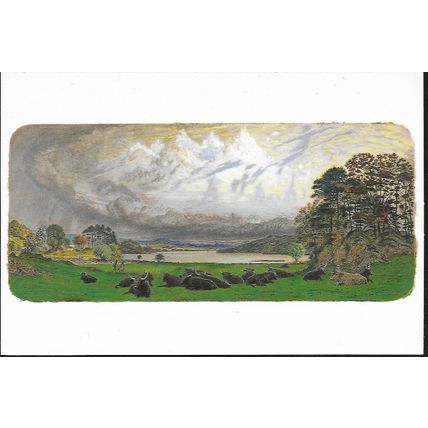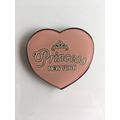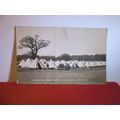Brown, Ford Madox - Windermere: a Storm, 1848 - art postcard
- Condition : Used
- Dispatch : 2 Days
- Brand : None
- ID# : 200159653
- Quantity : 1 item
- Views : 193
- Location : United Kingdom

- Seller : justthebook (+1703)
- Barcode : None
- Start : Sat 10 Apr 2021 18:32:26 (EDT)
- Close : Run Until Sold
- Remain : Run Until Sold
Checks/Cheques
 for 1 item(s) edit
for 1 item(s) edit
Shipping Calculator
More Listings from This Seller view all
Seller's Description
- Art Postcard
- Work of art title: Windermere: a Storm 1848
- Artist (if known): Ford Madox Brown (1821-1893)
- Media or other details: Watercolour and body colour
- Publisher / Gallery: Tullie House Museum & Art Gallery, Carlisle
- Postally used: no
- Stamp & postmark details (if relevant):
- Size: Modern
- Notes & condition details: near mint
NOTES:
Size: 'Modern' is usually around 6in x 4in or larger / 'Old Standard' is usually around 5½in x 3½in. Larger sizes mentioned, but if you need to know the exact size please ask as this can vary.
All postcards are not totally new and are pre-owned. It's inevitable that older cards may show signs of ageing and use, particularly if sent through the post. Any faults other than normal ageing are noted.
Stock No.: A1058
Please ask if you need any other information and I will do the best I can to answer.
------------------------------------------------
Postage and packing charge should be showing for your location (contact if not sure).
UK - PayPal, Cheque (from UK bank) or postal order
I will give a full refund if you are not fully satisfied with the postcard.
----------------------------------------------
Ford Madox Brown (16 April 1821 – 6 October 1893) was a British painter of moral and historical subjects, notable for his distinctively graphic and often Hogarthian version of the Pre-Raphaelite style. Arguably, his most notable painting was Work (1852–1865). Brown spent the latter years of his life painting the twelve works known as The Manchester Murals, depicting Mancunian history, for Manchester Town Hall.
Brown was the grandson of the medical theorist John Brown, founder of the Brunonian system of medicine. His great grandfather was a Scottish labourer. His father Ford Brown served as a purser in the Royal Navy, including a period serving under Sir Isaac Coffin and a period on HMS Arethusa. He left the Navy after the end of the Napoleonic Wars.
In 1818, Ford Brown married Caroline Madox, of an old Kentish family.[1] Brown's parents had limited financial resources, and they moved to Calais to seek cheaper lodgings, where their daughter Elizabeth Coffin was born in 1819 and their son Ford Madox Brown in 1821.
Brown's education was limited, as the family frequently moved between lodgings in the Pas-de-Calais and relatives in Kent, but he showed artistic talent in copying of old master prints. His father initially sought a naval career for his son, writing to his former captain Sir Isaac Coffin. The family moved to Bruges in 1835 so Brown could study at the academy under Albert Gregorius. Brown moved to Ghent in 1836 to continue his studies under Pieter van Hanselaere. He moved to Antwerp in 1837 to study under Gustaf Wappers. He continued to study in Antwerp after his mother's death in 1839. His sister died in 1840, and then his father in 1842.
The Tate Gallery holds an early example of Brown's work, a portrait of his father.[2] He first exhibited at the Royal Academy in 1840, a work inspired by Lord Byron's poem The Giaour (now lost) and then completed a version of The Execution of Mary, Queen of Scots, with his cousin and future wife Elisabeth Bromley as one of his models. He lived in Montmartre with his new wife and aging father in 1841. He painted Manfred on the Jungfrau, inspired by Lord Byron's poem Manfred while he was in Paris.
In 1843 he submitted work to the Westminster Cartoon Competition, for compositions to decorate the new Palace of Westminster. His entry, The Body of Harold Brought before William, was not successful. His early works were, however, greatly admired by the young Dante Gabriel Rossetti, who asked him to become his tutor. Through Rossetti, Brown came into contact with the artists who went on to form the Pre-Raphaelite Brotherhood. Though closely linked to them, he was never actually a member of the brotherhood itself, but adopted the bright colours and realistic style of William Holman Hunt and John Everett Millais. He was also influenced by the works of Holbein that he saw in Basel in 1845, and by Friedrich Overbeck and Peter Cornelius, whom he met in Rome in 1845–46.
Brown struggled to make his mark in the 1850s, with his paintings failing to find buyers, and he considered emigrating to India. In 1852 he started work on two of his most significant works.
One of his most famous images is The Last of England, painted from 1852 to 1855, which was sold in March 1859 for 325 Guineas[3] (2010: £26,700). It depicts a pair of stricken emigrants as they sail away on the ship that will take them from England forever. It was inspired by the departure of the Pre-Raphaelite sculptor Thomas Woolner, who had left for Australia. In an unusual tondo format, the painting is structured with Brown's characteristic linear energy, and emphasis on apparently grotesque and banal details, such as the cabbages hanging from the ship's side. The husband and wife are portraits of Brown and his second wife Emma.
Listing Information
| Listing Type | Gallery Listing |
| Listing ID# | 200159653 |
| Start Time | Sat 10 Apr 2021 18:32:26 (EDT) |
| Close Time | Run Until Sold |
| Starting Bid | Fixed Price (no bidding) |
| Item Condition | Used |
| Bids | 0 |
| Views | 193 |
| Dispatch Time | 2 Days |
| Quantity | 1 |
| Location | United Kingdom |
| Auto Extend | No |





















